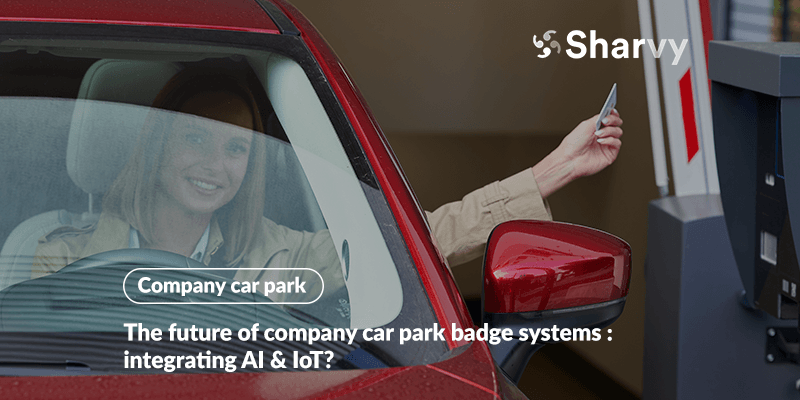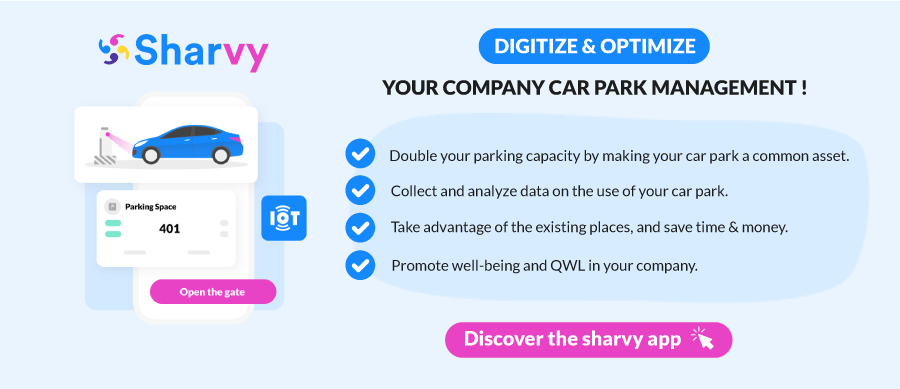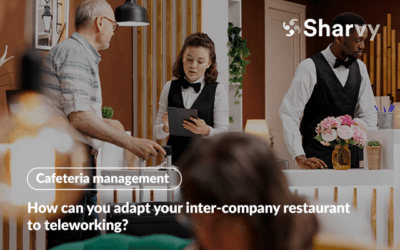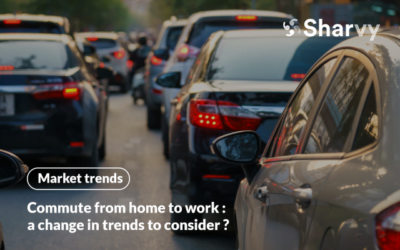For a long time, the (physical) car park access badge was the norm in many companies. Simple, effective and inexpensive to set up, they have met an essential need: secure entry and exit control.
But with changing ways of working – teleworking, flex office, shared mobility – our habits are changing, and the limits of these traditional systems are becoming increasingly apparent.
Against this backdrop, new technologies such as the Internet of Things (IoT) and artificial intelligence (AI) are shaking things up. Not to replace everything overnight, but to bring greater flexibility, fluidity and intelligence to the company car parks management.
In this article, we take a look at this ongoing transition: between traditional badges, intelligent sensors and predictive algorithms, what will corporate parking look like tomorrow?
Traditional badge systems for company car parks: current situation.
Today, the majority of companies still use physical badges, often based on RFID technology, to manage access to car parks. For many organisations, this is still an effective way of meeting day-to-day needs.
However, these devices (although simple to implement) have a number of obvious limitations: they can be lost, shared or hacked, which raises security issues. At the same time, their logistical management (delivery, deactivation, renewal) is tedious, especially in large organisations.
Of course, they meet a basic functional need: opening a gate when a new employee arrives. But in an increasingly mobile and hybrid business world, this model is showing its flaws. It lacks flexibility, cannot monitor usage in real time, and cannot easily adapt to scenarios such as carpooling and reserving spaces according to the number of days an employee is in the office.
IoT at the service of intelligent parking.
1. A simplified experience thanks to applications.
Forget about managing badges, distributing remote controls and manually activating access. Today, solutions like Sharvy allow you and your employees to manage car park access directly from a mobile application.
In just a few seconds, everyone can reserve a parking space and, when the day comes, open the barrier using a simple button in the application: only if a reservation is active.
This makes for a much smoother, more intuitive experience. There’s no longer any need to go through reception or the HR department to obtain a temporary badge: everything can be done independently, from a smartphone. Your employees save time, avoid unforeseen events… and get their day off to a better start.
At the same time, it’s a real plus for you, as the manager or person responsible for the working environment: fewer administrative tasks, fewer forgotten badges, and a solution that adapts easily to the current organisation, especially if you’ve adopted hybrid working such as flex office.
2. Conditional & secure access.
Ensuring the security of a car park while facilitating access for the right people is a real challenge. With traditional systems, it’s not uncommon to see a few things go wrong: a badge passed from hand to hand, a barrier left open ‘to help out’, & employees accessing the car park without really needing a space that day.
As a result, you gradually lose control over how the car park is actually used.
Where a solution like Sharvy makes a difference is that it introduces a clear rule: access is only granted if a reservation is in progress. In other words, your employees can only open the barrier if they have a space reserved. This is done via a button integrated into the application, linked directly to an IoT module connected to the barrier’s automatic system.
This system limits abuse, while giving you a clear, real-time view of entries and exits. Every action is recorded and associated with a user, without any manual intervention on your part.
And the best part is that this enhanced security is completely invisible to the user. No badge to search for, no code to enter: everything is done from the application, with just one click. It’s both stricter and simpler. Your employees feel supervised, but not constrained, and you gain peace of mind.
3. Less management, more agility for the company.
Company car park management is often more time-consuming than you think. Between requests for access, manual allocation of spaces, management of lost or obsolete badges, and day-to-day unforeseen events… it can quickly become a real headache for the teams in charge. And yet it’s rarely these tasks that add the most value to your business.
With a solution like Sharvy, you can automate a large proportion of these tasks.
Employees reserve their seats themselves in just a few clicks, and access is then managed autonomously via the application and its connected open button. You no longer need to intervene manually for each request, or chase after Excel lists or paper schedules.
This type of tool also makes it easier to deal with unforeseen events: an absent member of staff, a space freed up at the last minute, a new person to welcome on a one-off basis? The system adjusts in real time.
You become more responsive, your employees more autonomous, and your organisation becomes more flexible, more fluid, and better adapted to the realities of hybrid working.
Artificial intelligence: towards predictive & personalised management?
1. AI for anticipation.
What if your company car park was waiting for you before you even thought about it?
One of the great advantages of Artificial Intelligence (AI) in parking management is its ability to analyse past usage data to predict future behaviour.
It is now possible to anticipate the arrival time of each employee, based on their habits over the last three months. In practical terms, this means that the barrier can be prepared to open at the right time.
The system detects that an employee has an active reservation, and everything is put in place: a « button Opening the » barrier is displayed (in the form of a pop-up) as the employee approaches, without the need for a badge to be scanned or multiple clicks in the application. A fluidity of use that, on the surface, seems trivial, but really does change everyday life.
It’s a small detail, but one that really transforms the employee experience. We’re moving from an active user approach to an intelligent, proactive service that anticipates needs rather than simply responding to them.
And in a way, it’s also nice to feel that the technology is adapting to your employees’ daily lives, without becoming intrusive. This gentle, almost invisible form of automation saves time while eliminating the little irritants of everyday life. And that’s far from being just a gadget.
2. A smoother, more personalised experience.
Beyond forecasting, artificial intelligence also makes it possible to personalise the experience for each user.
Depending on their habits over the last few months, the days they are present and their mode of transport, the tool can suggest suitable locations and reminders. This saves your employees having to do the same thing over and over again, while offering them added convenience.
It’s thanks to these little touches that technology becomes truly useful, almost human. It adapts to your employees, rather than imposing a single, rigid way of working. As I said earlier, we’re moving from a management tool to an intelligent assistant, capable of evolving with the pace of each individual & the new practices associated with hybrid working.
And in a way, it’s also a form of recognition: offering your teams a simple, fluid & personalised experience means telling them that their time counts and that we’ve thought of them, even on their morning commute.
3. Continuous optimisation, discreetly.
What we often forget about artificial intelligence is that it doesn’t just carry out tasks: it learns, adapts and constantly improves. And it does all this without ever disturbing the user.
In the background, it observes behaviour, identifies usage trends, spots inconsistencies & wasted resources (such as reserved but unused spaces) and automatically adjusts the rules to better distribute availability.
This silent intelligence allows you to fine-tune your car park management on an ongoing basis, without overloading your teams or overhauling cumbersome processes. The system becomes more relevant each time it’s used, simply because it has a better understanding of what’s working and what’s not.
For the company, the benefits are tangible: fewer unoccupied zones, fewer allocation conflicts & optimised capacity, without ever complicating the user experience. It’s a bit like having an invisible car park manager, always adjusting the settings so that everything runs smoothly, without you even having to think about it.
Challenges to overcome.
While the promises of AI and IoT in car park management are undeniable, their deployment also raises a number of challenges that should not be underestimated. For a solution to be truly effective (and accepted), it is crucial to anticipate these obstacles with a clear head.
1. The security of personal data.
This is undoubtedly the most sensitive issue today. An intelligent solution necessarily collects data linked to the habits of each employee. And in a context where privacy issues are at the heart of concerns, compliance with the RGPD and the implementation of solid cybersecurity mechanisms are imperative.
Your employees need to know that their information will not be misused or compromised.
It’s not just a question of regulatory compliance, it’s also a question of trust: if your employees feel that their digital lives are being scrutinised & inadequately protected, their support for the service is likely to plummet, no matter how good the tool.
2. Cost & interoperability.
Installing a company car park management solution often involves investment in hardware and software. IoT sensors, integration with existing automation systems, maintenance, upgradability, etc. These costs can hold some companies back, particularly if their current infrastructure is old and not very compatible.
It is therefore essential to choose solutions that can integrate seamlessly with existing systems, such as Sharvy. These solutions can interact with existing badges & connect to barriers via simple IoT modules. A modular & incremental approach (often) keeps costs down while ensuring smooth deployment.
3. User acceptability.
Finally, even the best technology in the world is useless if it is not adopted. So one of the key issues is acceptability: your employees need to understand the benefits of the system, see the added value, and above all be able to use it without friction.
This requires clear instruction, simple interfaces, assistance when needed… but also honest communication about how the tool works, its objectives, and the guarantees in terms of confidentiality.
The feeling of being monitored or coerced is a major obstacle. Conversely, if the experience is fluid, personalised and respectful, acceptance comes naturally.
In conclusion
At a time when companies are rethinking their workspaces and seeking to optimise every square metre, car parks are no exception to the digital transformation. The integration of AI and IoT is no longer the stuff of science fiction: it’s a logical and accessible development that meets real needs in terms of comfort, efficiency and flexibility.
And what’s striking is that this modernisation can be carried out smoothly, without revolutionising everything at once: by building on what already exists, and moving forward in stages.
Of course, some challenges remain, but they are far from insurmountable. And if the initial feedback from Sharvy customers is anything to go by, it ‘s well worth the effort: a more fluid car park means a less stressful day-to-day life, greater respect for the rules of sharing, and ultimately a calmer and fairer working environment.
So why wait?
Got a question? Check the FAQ!
Are these technologies just for large companies?
Not at all. There are many solutions today that are suitable for SMEs, and even for smaller organisations with a limited number of seats. The important thing is to identify the real needs (fluidity, fairness, automation) rather than focusing on size. Some platforms offer scalable models that adapt to the number of users and the complexity of the site. This is what the Sharvy application offers.
Do you have to equip the entire company car park to start with?
No. It’s perfectly possible to start with a test area, such as a subset of employees. This allows you to assess usage, adjust the parameters and encourage internal support. This type of gradual roll-out is often more effective than a sudden change.
Is it really worth it if the company car park isn't often full?
Yes, because it’s not just a question of managing saturation. Even when there are a lot of empty seats, these technologies provide greater visibility and fluidity. They enable your staff to see at a glance whether they have a seat, automate access and limit friction.
It’s also intelligent foresight: if your organisation changes in the future (flex office, teleworking, car sharing, etc.), you’ll be ready. A well-managed car park, even if it’s not very full, is a real lever for comfort and modernity.
Want to find out more? Check out our latest articles to stay up to date!
How can your inter-company restaurant adapt to teleworking?
Teleworking : how can you manage the number of people using your inter-company restaurant & adapt your offer to new working habits? Focus.
Change management : how to facilitate the adoption of a new tool?
What are the essential steps to facilitate change management in your company ? Our advice and best practices can be found here.
Commute from home to work : a change in trends to consider ?
Commute from home to work : what trends can be observed? What are the risks? How can they be improved? Focus in this article.
Subscribe to our newsletter!
PARKING & WORKPLACE MANAGEMENT SOLUTION
Car park management - Charging points monitoring - Desk booking - Booking by time slots
SUBSCRIBE TO THE NEWSLETTER
Receive the latest Parking & Workplace trends by email once a month.














